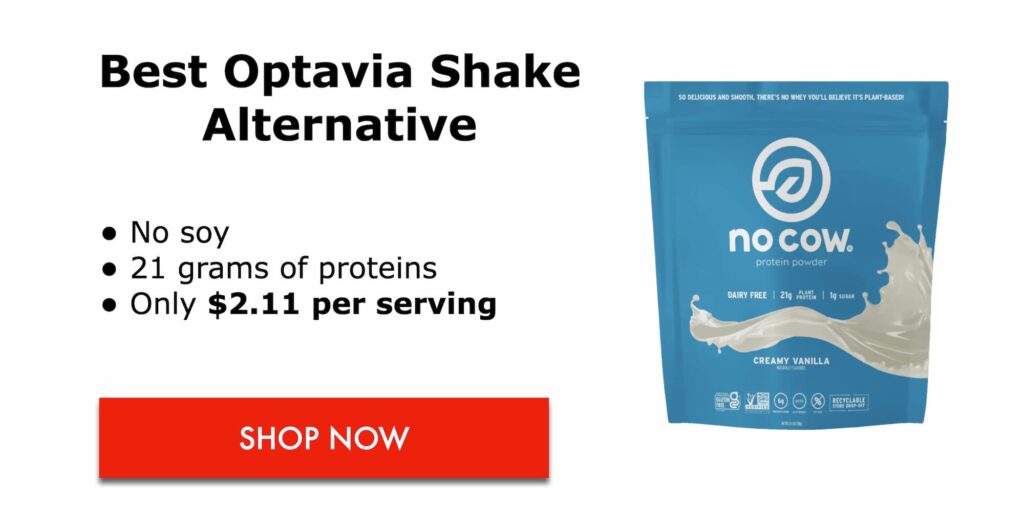Optavia diet, also known as Optavia 5 and 1, is a commercial weight-loss program developed by Medifast, Inc., offering meal replacement plans designed for calorie control. Optavia originated as a rebranding of Take Shape For Life, a personal Coach-to-client system created in 2002 by Retired Marine Colonel Bradley T. MacDonald and clinical specialist Dr. Wayne Scott Andersen.
The Optavia diet meal plan includes pre-portioned meal replacements, such as shakes, bars, and soups, along with one self-prepared “lean and green” meal consisting of lean protein and vegetables. The purpose of the Optavia diet plan is to facilitate weight loss and improve overall health through calorie deficit and coaching support.
A study published in Obesity Science & Practice in December 2018 compared the effectiveness of the Optavia 5&1 Plan with telephone coaching against other weight loss methods. The Optavia group experienced a significant reduction in body weight by -5.7%, fat mass, and abdominal fat mass compared to a self-directed, reduced-calorie diet.
What is the Optavia Diet?
The Optavia Diet is a partial meal replacement weight-loss plan that involves eating pre-packaged processed foods called “Optavia fuelings” as well as homemade “lean and green” meals. It recommends eating six or seven times per day, approximately every two to three hours.

The Optavia fuelings constitute at least half of the diet and contain around 100-110 calories each, leading to an estimated daily caloric intake of 500-550 calories. The remaining portion of the diet consists of “lean and green” meals, which you can prepare yourself, order for delivery, or eat out, and these meals include lean protein, non-starchy vegetables, and healthy fats.
When asking about the Optavia 5&1 diet, it refers to the most popular plan called the Optimal Weight 5 and 1 Plan. This plan requires five Optavia snacks per day, each around 32 grams, with choices ranging from bars and shakes to desserts and hearty meals. The “1” stands for one home-cooked meal per day. The second most popular and slightly more flexible option is the Optavia 4 and 2 plan, which includes four Optavia Fuelings and two lean and green meals.
What are the different plans offered by the Optavia diet?
The Optavia diet consists of various plans and components designed to facilitate weight loss and healthy living.

Optavia 5 and 1 Plan
This weight loss plan, also called Optimal Weight 5 & 1 plan for weight loss, includes five Optavia Fueling and one Lean and Green meal, focusing on low-calorie, high-protein options.
The Optavia 5 and 1 Active Plan
The Optimal Weight 5 & 1 ACTIVE plan, also known as the 5&1 active program, is designed for individuals aiming to reach their ideal weight through a balanced regimen of nutrition and exercise. In addition to five Optavia Fuelings, this plan includes Optavia essential amino acids (EAA) to help maintain lean muscle mass.
Optavia 4 and 2 Active Plan
The Optavia 4 and 2 plan consists of four Optavia Fuelings, and two Lean and Green meals, and is geared towards those who require more calories or have different nutritional needs.
Optavia 3 and 3 Active Plan
The Optavia 3 and 3 maintenance plan features three Optavia Fuelings and three Lean and Green meals, aiming to maintain weight or for those transitioning off a stricter Optavia diet plan. It also includes Optavia essential amino acids (EAA) and Optavia whey protein.
How does the Optavia diet work?
The Optavia diet works through a combination of pre-portioned Optavia Fuelings— which include branded bars, shakes, cereals, and desserts— and self-prepared “lean and green” meals consisting of 5-7 oz of lean meat or meat substitutes, low-carb vegetables, healthy fats, and condiments.

Additionally, the Optavia weight loss program provides online coaching through weekly meetings with an Independent Optavia coach, either via calls or in-person sessions. The diet aims for a daily caloric intake of 800-1,000 calories to create a calorie deficit, and although a 2023 study in the Cerebrovascular Diseases journal found it to be a feasible and safe option for weight loss in overweight or obese patients, user reviews are mixed.
While some users enthusiastically report significant weight loss, success stories, and body transformations, others express concerns about rising costs, health risks, and potential negative consequences, including claims that “Optavia ruined my life.”
What are the health benefits of the Optavia diet?
The Optavia diet is designed for weight loss and offers additional health benefits such as improved metabolic function, better blood sugar control, enhanced cardiovascular health, increased energy levels, and reduced risk of chronic diseases.
- Weight Loss: The Optavia diet plan primarily focuses on calorie restriction to promote weight loss.
- Improved Metabolic Function: The 5&1 diet is formulated to enhance metabolic rates, aiding faster calorie burn.
- Better Blood Sugar Control: Optavia-approved meals may help regulate blood sugar levels.
- Enhanced Cardiovascular Health: Low-fat and nutrient-rich Optavia Fuelings can contribute to better heart health.
- Increased Energy Levels: Balanced Optavia snacks aim to provide sustained energy throughout the day.
- Reduced Risk of Chronic Diseases: The Optimal Weight 5 and 1 diet emphasizes nutrition and portion control may lower the risk of developing chronic conditions like diabetes and heart disease.
What are the health risks of the Optavia diet?
The Optavia diet poses potential long-term side effects such as nutrient deficiencies, gastrointestinal issues, potential negative impacts on kidney function, elevated risk for gallstones, and an unsustainable approach to weight loss.
- Nutrient Deficiencies: The restrictive nature of the Optavia weight loss program may lead to inadequate intake of essential nutrients.
- Gastrointestinal Issues: The sudden shift to low-calorie, high-fiber Optavia products can cause digestive problems like bloating and constipation.
- Kidney Function: The 5&1 diet’s high protein content could put extra strain on kidneys, particularly in those with pre-existing kidney issues.
- Gallstones: Rapid weight loss associated with the Optavia program may increase the risk of developing gallstones.
- Unsustainable Weight Loss: Optavia’s 5 and 1 plan strict regimen may be hard to sustain long-term, leading to potential weight regain.
How to do the Optavia diet?
To successfully follow the Optavia diet, take the following steps:

- Find a Coach: Locate an Optavia coach or contact Optavia customer service to assign one for you.
- Plan Selection: Discuss with your Optavia coach to choose the right Optavia weight loss plan tailored to your needs.
- Read Reviews: Look into Optavia 5 and 1 reviews as well as medical reviews by doctors for a comprehensive understanding.
- Know the Risks: Familiarize yourself with any long-term side effects associated with the Optavia diet.
- Study Guides: Go through all available Optavia guides, including the 5 and 1 guide and dining out guide, to understand the program thoroughly.
- Choose Fuelings: Select your favorite Optavia fuelings and shakes for your meal plan.
- Fueling Hacks: Visit the EatProteins website for creative hacks to make your Optavia fuelings more enjoyable.
- Organize Food List: Prepare your Optavia food list and create a weekly shopping list for all necessary items.
- Lean and Green Recipes: Source the best Optavia lean and green recipes to diversify your meal options.
What foods can you eat on the Optavia Diet?
On the Optavia Diet, you can consume a variety of foods across different categories:
- Proteins: Chicken breast, turkey, tofu, salmon, eggs, greek yogurt, cottage cheese, and lean beef.
- Low-Carb Vegetables: Broccoli, cauliflower, green beans, spinach, kale, zucchini, asparagus, bell peppers.
- Healthy Fats: Avocado, olive oil, almonds, walnuts, flaxseeds, chia seeds, coconut oil, sunflower seeds.
- Condiments: Mustard, salsa, apple cider vinegar, hot sauce, low-sodium soy sauce, lemon juice, fresh herbs, and garlic powder.
What condiments can you have on the Optavia Diet?
On the Optavia Diet, the condiment list is carefully curated to include low-calorie and low-sodium options like herbs, spices, and certain kinds of vinegar. In 2022, the Optavia condiment list was updated to feature a new range of herbs and spices, as well as flavor enhancers that include salad dressing.
What can you drink on Optavia Diet?
You can drink a variety of beverages on the Optavia diet, including plain water, sparkling water, unsweetened black and green tea, black coffee, and zero-calorie sodas like Pepsi Black and Diet Coke. Other Optavia-approved drinks are Gatorade Zero and Powerade Zero, as well as Propel water, which are all low in calories and sugar.
Is it okay to drink wine while following Optavia?
No, you can’t have alcohol on Optavia if you’re on the 5 and 1 plan. However, wine is allowed during the Optavia 3 and 3 maintenance phase.
What foods should you avoid on the Optavia Diet?
On the Optavia Diet, there are certain food categories that are generally advised to be limited or avoided:

- Fruits: Bananas, grapes, mangoes, pineapple, cherries, apples, oranges, and pears.
- Legumes: Lentils, chickpeas, black beans, kidney beans, pinto beans, navy beans, peanuts, and soybeans.
- Starches: Potatoes, sweet potatoes, corn, yams, squash, peas, plantains, and cassava.
- Grains: Rice, wheat, barley, oats, rye, quinoa, and millet.
What recipes are recommended for the Optavia diet?
The best recipes for the Optavia diet are those that adhere to its low-carb, high-protein guidelines while offering a satisfying eating experience. Optavia-approved dishes like Big Mac Salad, Egg Roll in a Bowl, and Cauliflower Pizza are standout options, creatively replicating classic flavors without compromising the diet’s nutritional principles.

Optavia Big Mac Salad
This recipe is a creative take on the iconic Big Mac, designed to fit within the Optavia diet’s guidelines. It includes ground beef, cheese, lettuce, and a special low-carb sauce, aiming to capture the essence of the fast-food favorite. This salad offers a satisfying meal that is both high in protein and low in carbs.
Optavia Egg Roll in a Bowl
This recipe takes the classic flavors of an egg roll and turns them into a one-pan dish, eliminating the high-carb wrapper. It features ground meat—usually pork or chicken—mixed with cabbage and a variety of spices, offering a quick and easy meal option. It’s a convenient way to enjoy the essence of an egg roll while sticking to the Optavia diet’s nutritional parameters.
Optavia Pizza Casserole
The Optavia Pizza Casserole replicates the flavors of a traditional pizza but in a low-carb casserole format. The recipe includes layers of cheese, pepperoni, and vegetables, all baked together to create a cohesive, pizza-like experience. This is an ideal dish for those who miss pizza but want to adhere to the Optavia diet’s guidelines.
Optavia Buffalo Chicken Dip
This flavorful dip combines shredded chicken with buffalo sauce and cream cheese, making it perfect for snacking or serving at gatherings. The recipe is high in protein and low in carbs, aligning well with the Optavia diet’s nutritional requirements. It provides a tangy and satisfying option for those looking to spice up their Optavia meal plan.
Optavia Cauliflower Pizza
This innovative recipe uses a cauliflower-based crust to offer a pizza experience that fits within the Optavia diet. The crust is made from grated cauliflower, cheese, and egg, then topped with Optavia-approved toppings like low-fat cheese and vegetables. This allows for a guilt-free pizza night that adheres to the nutritional limitations of the Optavia diet.
What is an Optavia Diet meal plan?
The following is the Optavia 5&1 sample meal plan.
- Breakfast – First Optavia Fueling: Chocolate Mint Cookie Crisp Bar
- Mid-morning – Second Optavia Fueling: Drizzled Berry Crisp Bar
- Lunch – Third Optavia Fueling: Essential Creamy Vanilla Shake
- Afternoon – Fourth Optavia Fueling: Zesty Cheddar & Italian Herb Crunchers
- Dinner – Lean and Green meal: 6oz of lean beef strips, bell peppers, and zucchini cooked in a low-sodium soy sauce
- Evening – Fifth Optavia Fueling: Essential Mint Chocolate Soft Serve
What snacks can you have on Optavia?
On the Optavia 3 and 3 plan, you can have a variety of free snacks that are allowed in moderation. These snacks include Hershey Kisses, muffins, low-fat ice cream, frosted cake, chocolate chip cookies, fat-free pudding, angel food cake, brownies, gingersnap cookies, vanilla wafers, mini ice cream sandwiches, fun-size candy bars, licorice twists, fruit snacks, fruit leather, dark chocolate (at least 70% dark), and unsweetened cacao nibs.
What are the facts about the Optavia diet?

- Annual Optavia Convention in Atlanta: Optavia holds an annual convention in Atlanta, where coaches, customers, and stakeholders gather to learn about new products and business strategies and network with others.
- MLM Company: Optavia operates as a Multi-Level Marketing (MLM) company, which means that coaches can earn commissions from their sales and from the sales of coaches they recruit.
- Coaches’ Discount: Optavia coaches are eligible for discounts on products, providing an incentive for people to become coaches beyond the potential for income from sales and recruitment.
- Not Registered Dieticians: Optavia health coaches are not necessarily registered dieticians, meaning that while they can provide general advice on the program, they are not qualified to offer specialized dietary or medical advice.
- Expensive: The cost of the Optavia diet can be high, with prices ranging from $485.10 to $571.45 per month, making it a significant financial commitment for most people.
- DIY Fuelings: Due to the high cost, many people choose to create DIY Optavia fuelings or seek cheaper alternatives, although these may not be as rigorously tested or quality-controlled as Optavia’s products.
How much does the Optavia diet cost?
The Optavia 5&1 Plan costs $511.50 per month, which includes 22 boxes of Optavia Fuelings for a total of 154 servings. The Optavia 3&3 Plan costs $485.10 per month, covering 13 boxes of Optavia Fuelings, one tub of Optavia Whey Protein, and two pouches of Optavia Essential Amino Acids, totaling 181 servings. These Optavia costs do not include additional expenses like taxes, delivery fees, and groceries for lean and green meals.
What can be used as Optavia fueling substitutes?
Orgain shakes and No Cow bars offer plant-based protein powders, shakes, and bars that can serve as cost-effective substitutes for Optavia fuelings.

- Orgain: Orgain offers plant-based protein powders and shakes that can be used as a substitute for Optavia fuelings, providing a similar macronutrient profile but often at a lower cost.
- No Cow: No Cow produces dairy-free protein bars that are low in sugar and carbs, making them a suitable alternative to Optavia fuelings for those looking to maintain their macronutrient intake while possibly saving money.
What are the differences between Optavia and Nutrisystem?
Optavia and Nutrisystem are both weight-loss programs, but Optavia incorporates a coaching component and leans more on meal replacement bars and shakes, whereas Nutrisystem focuses on portion-controlled, pre-packaged meals that are closer to traditional foods.
Is Optavia considered a healthy diet?
The Optavia diet is considered by some to be an effective weight-loss diet, as evidenced by a 2023 study published in the Cerebrovascular Diseases journal that found it feasible and safe for weight loss in overweight or obese patients. However, reviews are mixed, with some users complaining about potential health risks and high costs.
